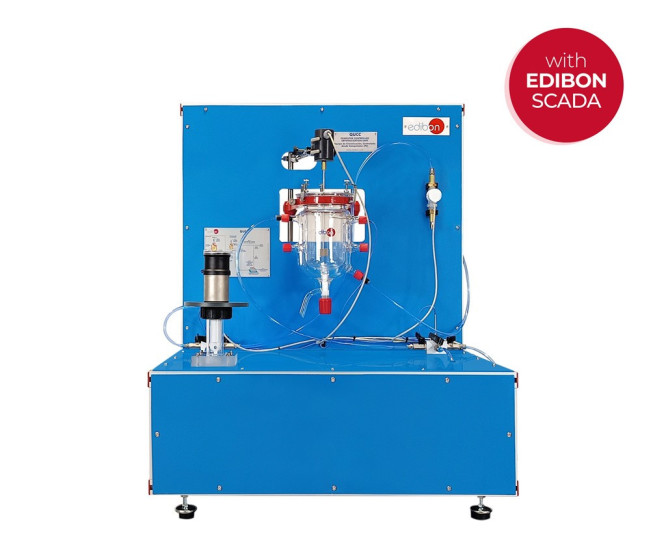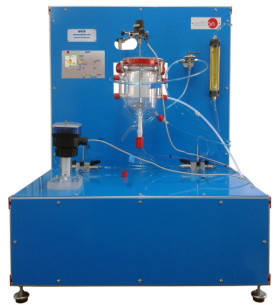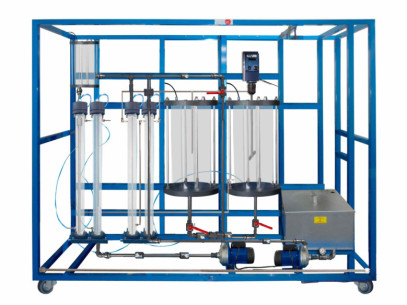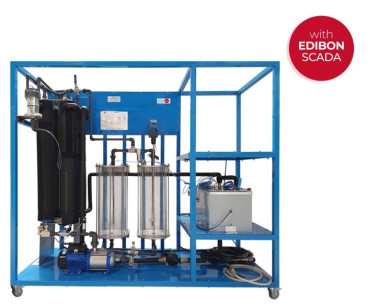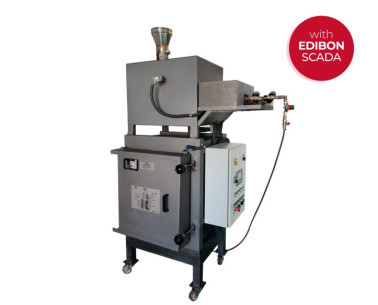QUCC Unité de Cristallisation, Contrôlée par Ordinateur (PC)
SYSTEMES INNOVANTS
L’Unité de Cristallisation, Contrôlée par Ordinateur (PC), "QUCC", conçue par EDIBON, est une unité de cristallisation par refroidissement. Par conséquent, elle est adaptée pour effectuer des expériences de cristallisation avec des constituants dont la solubilité varie en fonction de la température.
Expansions
Laboratories
NOUVELLES LIÉES
Description Générale
L'Unité de Cristallisation, Contrôlée par Ordinateur (PC), "QUCC", est une unité destinée à l'étude du processus de cristallisation par refroidissement. EDIBON a conçu cette unité pour étudier la réaction de cristallisation des constituants dont la solubilité varie avec la température.
Cette unité est conçue pour effectuer une cristallisation par lots, c'est-à-dire que le cristallisoir est rempli une fois avec le soluté et le solvant jusqu'à ce que la solution sursaturée soit obtenue et que des cristaux soient obtenus à partir de cette solution.
L'unité "QUCC" comprend un cristallisoir, qui est essentiellement un réacteur chimique à double enveloppe. Il y a un bain à l'extérieur du cristallisoir, à travers lequel la température de réaction est contrôlée. La solution est agitée par un agitateur situé sur le côté supérieur du cristallisoir. De plus, il y a un capteur de température sur le côté supérieur du cristallisoir pour connaître la température de la solution à l'intérieur à tout moment.
L'unité comprend également un capteur de conductivité pour connaître la conductivité de la solution lorsque cela est nécessaire.
Pour obtenir la solution sursaturée, il faut la chauffer pour qu'elle puisse dissoudre une concentration plus élevée de soluté à haute température. Un bain thermostatique est prévu pour alimenter en eau la chemise du cristallisoir. Son contrôle est effectué par le biais du logiciel au moyen d'un PID.
Une fois obtenue une solution sursaturée à haute température, l'étape de cristallisation commence. Pour cela, introduire de l'eau froide ou à température ambiante. L'appareil comprend une vanne de régulation de pression maintenue à la pression minimale.
Un échantillon du produit collecté est analysé à l'aide du jeu de filtres fourni avec l'appareil. La taille des cristaux générés peut ainsi être obtenue.
Avec l'élément supplémentaire recommandé Unité d'Alimentation Continue, Contrôlé par Ordinateur (PC), "QUCC/C", cette unité devient une unité de cristallisation continue.
Cette Unité Contrôlée par Ordinateur est fournie avec le Système de Contrôle par Ordinateur EDIBON (SCADA), et comprend : l'Unité elle-même + un Boîtier d'Interface de Contrôle + une Carte d'Acquisition de Données + des Progiciels de Contrôle par Ordinateur, d'Acquisition de Données et de Gestion de Données, pour contrôler le processus et tous les paramètres impliqués dans le processus.
Des exercices et pratiques guidées
EXERCICES GUIDÉS INCLUS DANS LE MANUEL
- Compréhension des principes de la cristallisation par refroidissement en solution.
- Etude de la distribution de la taille des cristaux.
- Opération par lots.
- Obtention de cristaux par la méthode du refroidissement.
- Démonstration des effets de la variation des paramètres suivants sur le processus de cristallisation :
- Concentration du soluté.
- Niveau d'agitation.
- Température de refroidissement.
- Flux d'alimentation en soluté (" QUCC/C" est requis).
PLUS D'EXERCICES PRATIQUES À EFFECTUER AVEC CETTE ÉQUIPEMENT
- Calibrage des capteurs.
- Bilans de masse et d'énergie.
- Évaluation de l'efficacité de la cristallisation et de la cinétique de cristallisation.
- Fonctionnement en continu ("QUCC/C" est requis).
Autres possibilités à réaliser avec cette unité :
- De nombreux étudiants voient les résultats simultanément. Pour voir tous les résultats en temps réel dans la classe au moyen d'un projecteur ou d'un tableau blanc électronique.
- Contrôle ouvert, multicontrôle et contrôle en temps réel. Cette unité permet intrinsèquement et/ou extrinsèquement de changer la durée, les gains, paramètres proportionnels, intégraux, dérivés, etc. en temps réel.
- Le système de contrôle informatique avec SCADA et Contrôle PID permet une véritable simulation industrielle.
- Cette unité est totalement sûre car elle utilise des dispositifs de sécurité mécaniques, électriques et électroniques.
- Cette unité peut être utilisée pour faire de la recherche appliquée.
- Cette unité peut être utilisée pour donner des cours de formation aux industries même à d'autres institutions d'enseignement technique.
- Contrôle du processus de l'unité QUCC via la boîte d'interface de contrôle sans l'ordinateur.
- Visualisation de toutes les valeurs de capteurs utilisées dans le processus de l'unité QUCC.
- En utilisant PLC-PI, 19 autres exercices peuvent être effectués.
- Plusieurs autres exercices peuvent être faits et conçus par l'utilisateur.
UNITÉS SIMILAIRES DISPONIBLES
Unité de Cristallisation Avancée
Unité de Cristallisation Avancée, Contrôlée par Ordinateur (PC)
EQUIPEMENT COMPLEMENTAIRE
Unité de Cristallisation
Unité de Cristallisation Avancée, Contrôlée par Ordinateur (PC)
Unité de Cristallisation Avancée
Unité pour la Pyrolyse, Contrôlée par Ordinateur (PC)
Qualité

Service après vente

 Préférences sur les cookies
Préférences sur les cookies

